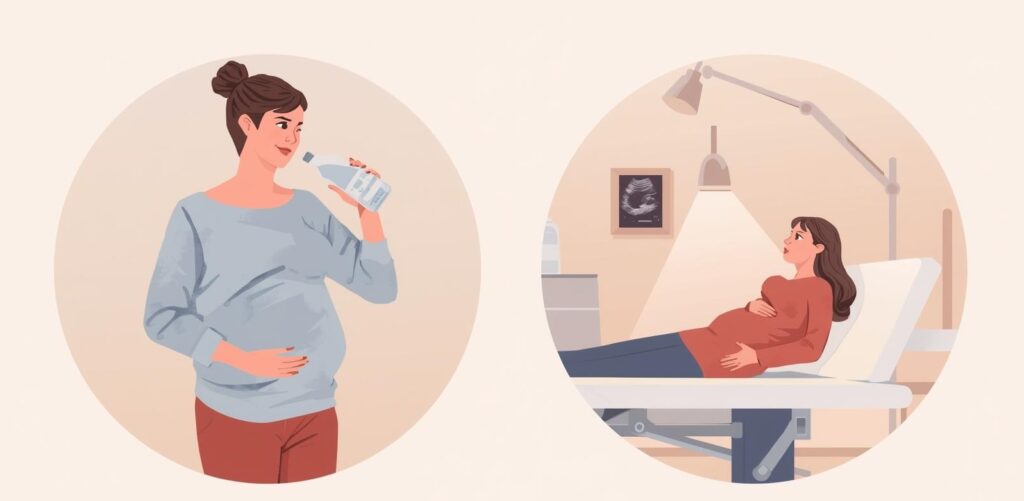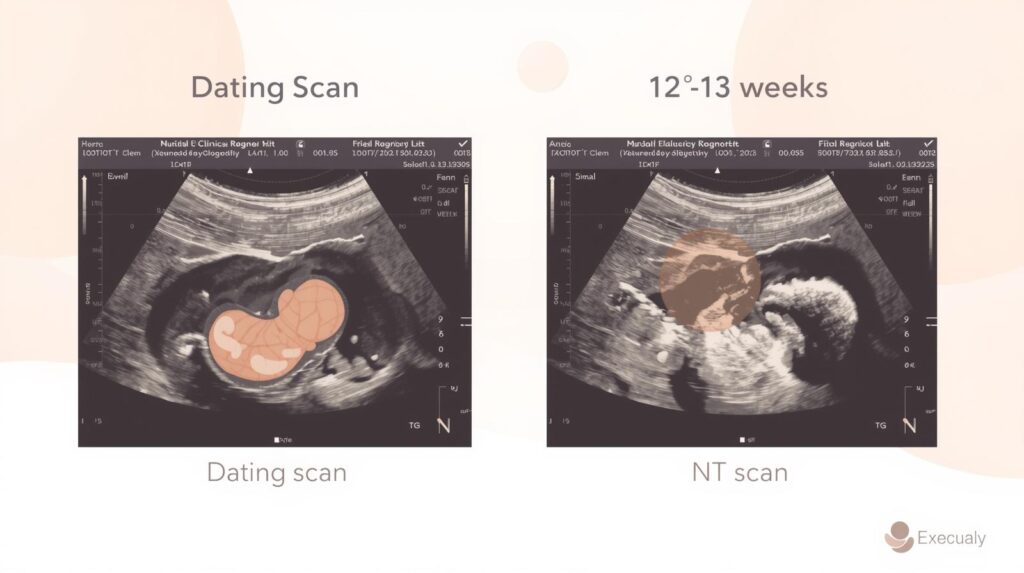A dating scan is an early ultrasound used to confirm a pregnancy, determine the estimated due date, and check the baby’s viability by measuring the fetus. Typically performed between 8 and 14 weeks, it is particularly helpful if the date of the last menstrual period is unknown. It can also identify multiple pregnancies and check for early signs of complications.
This initial peek into your growing baby’s world is a moment filled with anticipation, wonder, and sometimes, a few nerves. If you’ve been told you need a dating scan or have one coming up, you likely have more questions.
This comprehensive guide is designed to walk you through everything you need to know about this pivotal first ultrasound. We will demystify the process, explain what to expect, and help you understand the invaluable information this scan provides as you embark on your incredible journey to parenthood.
What is the Meaning of a Dating Scan?
A dating scan, also known as a viability or early pregnancy scan, is an ultrasound examination typically performed during the first trimester of pregnancy. Its primary purpose is twofold:
- To Determine Your Baby’s Gestational Age: The scan accurately measures your baby to estimate your due date. This is often more reliable than calculating from the first day of your last menstrual period (LMP), especially if your cycles are irregular, you are unsure of your dates, or you conceived while using contraception.
- To Confirm Pregnancy Viability: It checks that the pregnancy is developing as expected inside the uterus, confirms the presence of a heartbeat, and establishes that it is a single or multiple pregnancy (twins, triplets, etc.).

Think of it as the official “start line” for your pregnancy care, providing a crucial baseline that your healthcare team will use throughout the coming months.
How It Works for a Pregnant Mother
The dating scan is a safe and painless procedure that uses high-frequency sound waves to create an image of your baby inside the womb. There are two main types of scans you might experience:
- Transabdominal Scan: This is the most common type for a dating scan. A sonographer (a trained ultrasound professional) will spread a clear, water-based gel on your lower abdomen. They will then gently move a handheld device called a transducer over this area. The transducer emits sound waves that bounce off your baby, and the returning echoes are translated into images on a screen.
- Transvaginal Scan: In early pregnancy, especially if you are before 8 weeks, the sonographer might suggest a transvaginal scan for a clearer view. A long, thin, lubricated transducer is gently inserted into the vagina. This gets closer to the uterus and often provides more detailed images in the very early stages. It is safe and should not be painful.
You will be able to see the screen during the procedure, and the sonographer will explain what you are seeing.
What Week is Best for a Dating Scan?
The optimal window for a dating scan is between 8 weeks and 13 weeks plus 6 days of pregnancy.

- Before 7 weeks: It can be difficult to see the baby clearly or detect a heartbeat, which may cause unnecessary anxiety.
- 8 to 10 weeks: This is often considered the ideal time. The baby is large enough to get accurate measurements, and the heartbeat is usually clearly visible.
- 11 to 14 weeks: This still provides an accurate due date and is often when the Nuchal Translucency (NT) scan is combined with the dating scan.
Your doctor or midwife will advise you on the best timing based on your individual circumstances.
How Does the Baby Look During the Dating Scan?
Don’t expect a perfectly formed newborn just yet! In the first trimester, your baby will look quite different. What you will likely see on the screen includes:

- A Small, Curved Shape: Your baby will appear as a small, bean-shaped or tadpole-like figure.
- The Yolk Sac: A small circular structure that provides nutrients to the embryo in the very early stages.
- Flickering Heartbeat: One of the most magical moments is seeing the tiny flicker of your baby’s heartbeat. The sonographer will often measure the heart rate to ensure it’s within a normal range.
- Limb Buds: Little paddles where the arms and legs are starting to form.
- The Head: The head will be disproportionately large compared to the body at this stage.
The sonographer will take a standard measurement called the Crown-Rump Length (CRL)—the length of the baby from the top of its head (crown) to its bottom (rump). This measurement is the most accurate way to date an early pregnancy.
How Long Does a Dating Scan Take?
A dating scan is typically a quick procedure. The actual scanning part usually takes between 15 and 20 minutes. However, you should allow extra time for your appointment for checking in, possibly waiting, and for the sonographer to discuss the initial findings with you afterwards.
What Preparations Are Needed Before the Scan?
Preparation is generally simple, but it’s best to confirm with your ultrasound clinic.
- For a Transabdominal Scan: You will usually be asked to have a full bladder. A full bladder acts like an acoustic window, pushing the bowel out of the way and providing a clearer view of the uterus. Drink about two pints (one liter) of water an hour before your appointment and try not to empty your bladder.
- For a Transvaginal Scan: You will usually be asked to empty your bladder just before the procedure.

Wear comfortable, loose-fitting clothing that allows easy access to your lower abdomen.
Feel reassured and informed? Take the next step with confidence.
To confirm your due date and see your baby’s first heartbeat.
What Are the Benefits of Doing This Dating Scan?
The dating scan is far more than just a photo opportunity. Its benefits are foundational to your prenatal care:

- Accurate Due Date: Provides the most reliable Estimated Due Date (EDD), which is crucial for monitoring growth and planning for delivery.
- Confirmation of a Healthy Pregnancy: Confirming a heartbeat and an intrauterine pregnancy provides immense reassurance and rules out early complications like miscarriage or ectopic pregnancy.
- Determines the Number of Babies: Reveals whether you are expecting one baby, twins, or more!
- Baseline for Future Tests: The accurate dating is essential for interpreting the results of future screenings, such as the combined test for Down’s syndrome.
- Early Bonding: For many parents, seeing the baby’s heartbeat for the first time makes the pregnancy feel wonderfully real, strengthening the early bond.
What Should Be Done with the Dating Scan Results?
The sonographer will perform the scan and take the measurements. They will often give you verbal feedback immediately and may print some images for you to take home. A formal report will be sent directly to your referring doctor or midwife.
You should:
- Discuss the Results: Book a follow-up appointment with your doctor or midwife to formally discuss the report and what it means for your care plan.
- Update Your Records: Your due date and other details from the scan will be officially recorded in your maternity notes.
- Keep Your Scan Photos Safe: These first images are precious keepsakes from the start of your baby’s story.
Are Dating Scan and NT Scan the Same?
This is a common point of confusion. No, they are not the same, but they are often performed at the same appointment.

Dating Scan: The primary goal is to date the pregnancy and check viability. It can be done from 8 weeks onwards.
Nuchal Translucency (NT) Scan: This is a specific screening test for chromosomal conditions like Down’s syndrome, performed between 11 weeks and 13 weeks + 6 days. It measures the fluid at the back of the baby’s neck.
Because the NT scan requires very precise dating, the dating scan is an essential part of the process. Many clinics will do the dating measurements first and then immediately perform the NT scan if you are in the correct gestational window.
10 Frequently Asked Questions (FAQs) About Dating Scans
- Is the ultrasound gel safe?
Yes, the gel is specially formulated, water-based, and perfectly safe for both you and your baby. It is hypoallergenic and washes off easily with water. - Can I bring my partner or family members?
Absolutely! Most clinics encourage you to bring one or two support people. It’s a special moment to share. However, check the clinic’s policy, especially post-pandemic. - What if the scan shows something wrong?
The sonographer is trained to identify any potential issues. If they have any concerns, they will explain what they are seeing in a sensitive manner. You will be referred to your doctor or a specialist for further investigation and counseling. - Why was my due date changed by the scan?
This is very common. If your cycles are irregular or you ovulated later than day 14 of your cycle, the scan’s measurement (CRL) will provide a more accurate due date than one calculated from your LMP. - Can the scan determine the sex of the baby?
Not at this early stage. The baby’s genitalia are not fully formed until around 16-20 weeks. Determining the sex is typically done at the mid-pregnancy anomaly scan around 20 weeks. - What if no heartbeat is detected?
If you are less than 7 weeks, it might simply be too early. The sonographer will likely recommend a follow-up scan in 1-2 weeks. If there is no heartbeat when measurements suggest there should be, it may indicate a miscarriage. - Do I need a full bladder for a transvaginal scan?
No, in fact, you will be asked to empty your bladder for a transvaginal scan for comfort and to improve the view. - Is it really necessary? I know my dates.
Even with regular cycles, the scan can provide a more precise due date and offers the crucial benefit of confirming viability and the baby’s location, which simply cannot be determined from dates alone. - Can I have a 3D/4D scan instead?
In the first trimester, 3D/4D scans do not provide clear images because the baby is so small and underdeveloped. These are more useful in the second and third trimesters. The 2D ultrasound used for dating scans is the gold standard for early pregnancy assessment. - What does the heartbeat sound like?
During an early dating scan, you are more likely to see the heartbeat as a flicker on the screen rather than hear it. Some modern machines can produce an audible sound, but the visual confirmation is the key diagnostic feature.
The dating scan is a beautiful and significant step in your pregnancy. It provides the cornerstone for your antenatal care and offers that first, unforgettable glimpse of your little one. Go prepared, ask questions, and most importantly, take a moment to cherish this incredible milestone on your path to motherhood.
Ready to see your little one? Schedule your dating scan with us today and take the first step in your prenatal journey.
Disclaimer: This content is for informational purposes only and should not replace professional medical advice. Please consult a doctor for any questions or concerns.
